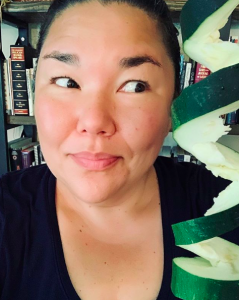Linda Black Elk is an Indigenous ethnobotanist, an educator, a forager, a gardener, a mother, and an activist. She is also an ardent advocate for food sovereignty, and she uses both an active social media presence and her position as a Food Sovereignty Skills Director at the United Tribes Technical College in Bismarck, North Dakota, to challenge our outdated ways of thinking about food. I spoke with Linda to learn more about food sovereignty and how the foodservice industry can support it on a large scale.

Linda Black Elk demonstrates how to prepare zucchini for drying.
How do you define food sovereignty?
I suppose on an individual level, food sovereignty to me is eating the food of my ancestors as much as possible, eating locally as much as possible. If I’m going to talk about sustainability and if I’m going to talk about food sovereignty, I have to practice that in my everyday life. Something that’s very important in my life is the belief that food is medicine. I take that very literally. If we’re eating the foods that we’re supposed to be eating, we won’t have many of the health issues that have plagued Indigenous communities for a few generations now.
Where is the intersection between food sovereignty and sustainability?
You really cannot be a sovereign person if you’re not sustainable. It’s the difference between food security and food sovereignty. Food security is just having enough calories, making sure you have enough to eat. Food sovereignty is all about choices. If you want to practice food sovereignty, you have to practice sustainability. If I decide I want to be a food sovereignty activist, and I go out and start harvesting without any consideration for the long term, I’m going to be in trouble next year. I’m not going to be able to make those same good choices next year because I was not sustainable in the previous season. Sustainability is what makes food sovereignty a long term choice.
“Food Sovereignty is the right of peoples to healthy and culturally appropriate food produced through ecologically sound and sustainable methods, and their right to define their own food and agriculture systems.” – La Via Campesina, who coined the term in 1996
Is food sovereignty of particular importance to Indigenous communities?
Food sovereignty is probably one of the biggest issues for Indigenous communities right now. We have food sovereignty summits, we have all kind of meetings and organizations. I teach a class in food sovereignty, and the reason for the interest is that people are starting to see the issues with our current system.

Who are your students? Who is looking to learn about food sovereignty?
I have a large following on social media because so many people, from all walks of life, are so interested in food sovereignty and sustainability. There is certainly an element of people who come to me because they are scared. There are those who are fearful of the future and are concerned about the collapse of the economy and the current food system that is not sustainable at all. I do believe that system is crumbling and that due to multiple issues, including the pandemic, we may face food shortages or food security issues. There are definitely those folks who follow me because they are fearful of those things. Most of my in-person students are Indigenous, who really want to get back to the land and traditional ways of doing things. They’re seeing how important it is to get back to those traditional ways because the current system isn’t working, particularly for people of colour. I’d say one of the biggest issues with that western food system and capitalism and a lack of sustainability, is that it has relegated Indigenous people to being in the high-risk category. We have much higher incidences of heart disease, diabetes, asthma. A lot of my students are saying, “I don’t want to be in a high-risk category anymore. I don’t want my children to be in a high-risk category anymore.”
How can food sovereignty be realized on a larger scale?
It’s a really big issue. I think that the food industry could look at the example being set by Indigenous chefs and the types of foods that they’re preparing and the type of ingredients they need, and make these foods attainable for average people with average incomes. I would like to see more people using traditional Indigenous ingredients, and wild ingredients. Wild foods are more sustainable and better for the environment. My friends and I have coined this term invasivore — trying to consume as many non-native and invasive species as possible so we can see a restoration of traditional plants. For example, garlic mustard is delicious, it makes an amazing pesto, you can dry it and use it in spice blends, it makes a great salad green — but it’s decimating ecosystems all across North America. If the restaurant industry could come up with ways to use it and create a market for it, we could get rid of a lot of it.
Follow Linda Black Elk on Facebook and Instagram @linda.black.elk

